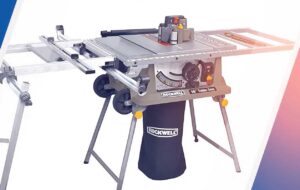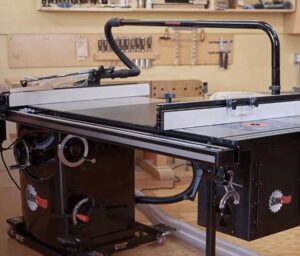A table saw is a highly productive woodworking tool comprising a number of features.
One of these is the table saw rip capacity.
For anyone who is looking to purchase a table saw for their home use or for professional use, it is essential to consider the rip capacity in order to choose the most suitable table saw, satisfying all their requirements.
Therefore, it is essential for you to understand what is rip capacity.
Put into simple words, table saw rip capacity is the distance between the edge of the table saw and its fence when the fence has been extended to the maximum.
It is this factor that determines the maximum width of which the wooden, plastic, or any cutting material sheet can be cut.
However, you must not confuse the rip capacity of the table with the maximum cutting width.
Rip capacity is just a determining factor and the actual maximum cutting is different from the rip capacity.
In addition to this, you adjust the rip capacity of your table saw based on your needs by sliding the fence.
Tab saw rip capacity can be maximized by removing the fence altogether.
For example, you can cut a 24” hardwood sheet using a table saw with a rip capacity allowing a maximum of 20”.
However, you might need to draw a line on your wooden sheet and follow that line while cutting or even build your own fence to make up for the absence of the fence you have removed.
Table Saw Rip Capacity
Different Table Saws come with different rip capacities depending on the maximum cutting width of the table saws.
The larger the rip capacity, the larger will be the scale of the projects for which the table saws can be effectively used.
In addition to this, the major difference between portable and stationary table saws is also their rip capacity.
Portable Table Saws are much smaller and are more commonly used by hobbyists for small DIY projects.
Hence, their rip capacity is also very small compared to stationary table saws.
The average capacity of portable saws ranges between 20 – 28 inches with only a few rare saws having a capacity of more than 30 inches.
On the other hand, stationary table saws are used for large-scale projects and have an average rip capacity of more than 50 inches.
These saws are very large and heavy compared to portable table saws.
Below we have discussed the most common rip capacities found in a majority of the table saws available.
Portable Table Saws (28 inches)

Portable Table Saws are affordable saws and a majority of them have a very low rip capacity of around 28 inches.
This rip capacity allows you to cut wooden sheets with a maximum width of 48 inches.
This is sufficient enough for hobbyists and small-scale projects like DIY crafts and altering furniture.
Contractor Table Saws (30 inches)

Contractor Table Saws are a type of stationary saw but are cheaper than the most powerful saw, the cabinet saws.
They have a rip capacity of 30 inches which many woodworkers and regular table saw users find ideal.
Cabinet Table Saws (50 inches)

Cabinet table saws are a dream tool for every professional woodworker.
They are the most powerful saws available on the market and have a maximum rip capacity of 50 inches.
This very large rip capacity allows them to efficiently cut into very large and dense sheets of wood or any other cutting material.
Another benefit of 50-inch rip capacity is that it allows you to perform a ‘square cut’.
Thus, a rip capacity of 50 inches is ideal for industrial work and large building projects.
It is the most common rip capacity for table saw found in woodcutting and glass factories.
How Much Rip Capacity Is Required?
As discussed earlier, the amount of rip capacity required depends on the user itself and the projects the user intends to work with the particular table saw.
It is these projects that will determine your maximum cutting width and thus, the rip capacity required to cut that width.
Therefore, the real question is what type of woodcutting will you plan on doing and what time of cuts you wish to perform?
For example, if you wish to work with plywood and OSB sheets for construction or for the purpose of crafting furniture pieces, a rip capacity of 24-28 inches is more than sufficient.
This rip capacity can easily cut 4-inch wide sheets that are mostly used at construction sites.
Most professionals and woodcutters find this rip capacity ideal.
However, if you require a table saw as a hobbyist and only for home use, then you should go for small portable saws of a rip capacity of 20 inches.
For industrial purposes, a much larger rip capacity is deemed more suitable.
Many industries, including the glass and plastic industries, use table saws for large-scale projects. In such a case you must choose a saw with a rip capacity of at least 50 inches.
This will ensure that your table saw performs efficiently and your cuts are accurate and precise.
Hence, before purchasing you can create a mock table saw using any table inside your home and check how much rip capacity will be ideal for you.
Another determining factor for the rip capacity is the price.
The larger the rip capacity, the higher will be the price of the table saw.
As you increase the rip capacity of your saw, the price tag will also continue to increase.
This is evident from the fact that portable saws with a higher rip capacity of around 30 inches are a lot more expensive than most portable table saws.
Therefore, before deciding on the most suitable rip capacity for yourself, you must first identify your budget.
If you are willing to openly spend, then you can invest in a table saw with a large rip capacity which will allow you to work comfortably with great precision.
However, do not waste your money on the larger rip capacity if you have very small requirements.
How Can You Increase the Rip Capacity of the Table Saw?
Rip capacities of most table saws are flexible and can be easily adjusted.
This is due to the fact that by sliding the fence, the distance between the edge of the table saw and the fence can change, and thus, the rip capacity can change.
However, when sliding the fence, you must ensure that the fence is stable and secure to prevent any accidents or mishaps.
In order to reach the maximum rip capacity, it is possible to remove the fence.
Table Saws with a rip capacity of 25 inches can rip material as wide as 44 inches by removing the fence.
However, there is a downside to this as well.
As fences are installed to ensure accuracy, you put the accuracy and precision of your cuts at great risk by removing the fences.
Another way to extend the rip capacity of your table saw is by making an additional table and attaching it to your original table saw.
This will increase the surface area of your tabletop and will also, consequently, increase the rip capacity.
However, this method does not work with table saws having a rack and pinion fence system and is more suitable for saws equipped with a clamped fence system.
Moreover, the rip capacity can also be increased by purchasing a table extension for your table saw from the manufacturers of the saw.
The extensions provided by the manufacturer are much more reliable and very easy to set up.
It is also the most convenient method as you do not have to do any work by yourself other than just purchasing and setting it up.
In addition to this, in some table saws, there is a difference between the rip capacity on the left side of the blade and the right side of the blade.
The rip capacity on the right side is usually larger.
Rip Capacity VS Table Saw Depth
Many people often confuse rip capacity with a table saw depth and fail to distinguish between.
This is completely wrong as both are entirely different from each other.
While the rip capacity determines the horizontal width of the sheets, the table saw depth refers to how deep will the cut be.
As mentioned earlier, rip capacity is the space available on the tabletop. On the other hand, table saw depth depends on the circular blade of the saw.
The larger the diameter of the saw will be, the deeper will be the cut made into the wood.
Thus, this tells how deep your blade will penetrate into the wooden sheets.
Most table saws are equipped with a 10-inch sharp blade that can perform a cut as deep as 3.5 inches.
According to most contractors and woodcutters, this is the ideal table saw depth and can cut into the densest materials like plywood and lumber.
Moreover, unlike the table saw rip capacity, the table saw depth does not affect the price of the saw.
The depth of the table saw can be varied by changing the blades.
It is only the size of the blades and their sharpness that determines the saw depth.
Conclusion
Among all of the table saw features, capacity is the most important one.
It is the most crucial factor to consider while purchasing the table saw as it is the one that determines the maximum cutting width of the sheets that will be ripped off by using the table saw.
In addition to this, the rip capacity also determines the price. The greater the rip capacity, the higher the rip capacity.
Moreover, the amount of rip capacity you will require depends on the type of projects you will be working on.
For large-scale projects and industrial uses, greater rip capacity is required, whereas, for small-scale projects, a rip capacity of around 20 to 25 inches is more than sufficient.
However, the rip capacity can be increased by adjusting the fence or by purchasing an extension of your table saw.
In conclusion, you must choose the rip capacity according to your budget and your requirements.
Remember not to go for extra-large rip capacities if you are a hobbyist or a newbie as it will be a waste of money!

